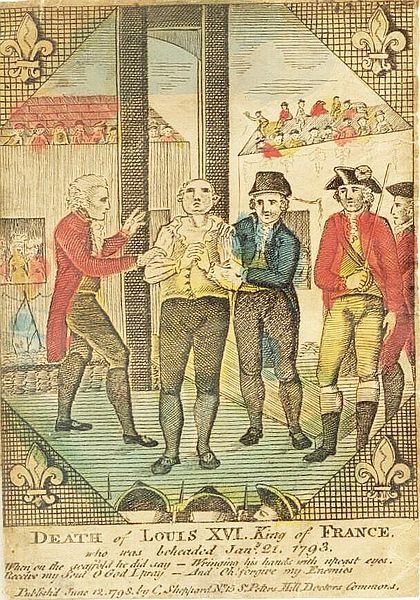|
|||
|
Philatelia.Net / French revolution / Plots / The directory «Plots»The execution of Louis XVILouis was officially arrested on the 13 August 1792, and sent to the Temple, an ancient fortress in Paris that was used as a prison. On 21 September, the National Assembly declared France to be a Republic and abolished the Monarchy. Louis was stripped of all of his titles and honours, and from this date was known as simply Citoyen Louis Capet. The Girondins were partial to keeping the deposed king under arrest, both as a hostage and a guarantee for the future. The more radical members – mainly the Commune and the Parisian deputies who would soon be known as the Mountain – argued for Louis's immediate execution. The legal background of many of the deputies made it difficult for a great number of them to accept an execution without the due process of law of some sort, and it was voted that the deposed monarch be tried before the National Convention, the organ that housed the representatives of the sovereign people. In November 1792, the Armoire de fer incident took place at the Tuileries Palace. This was believed to have been a hiding place at the Royal apartments, where some secret documents were kept. The existence of this iron cabinet was publicly revealed to Jean-Marie Roland, Girondinist Minister of the Interior. The resulting scandal served to discredit the King. On 11 December, among crowded and silent streets, the deposed King was brought from the Temple to stand before the Convention and hear his indictment, an accusation of high treason and crimes against the State. On 26 December, his counsel, Raymond de Sèze, delivered Louis's response to the charges, with the assistance of François Tronchet and Malesherbes. On 15 January 1793, the Convention, composed of 721 deputies, voted on the verdict. Given overwhelming evidence of Louis's collusion with the invaders, the verdict was a foregone conclusion – with 693 deputies voting guilty, none for acquittal, with 23 abstaining. The next day, a roll-call vote was carried out to decide upon the fate of the King, and the result was uncomfortably close for such a dramatic decision. 288 of the Deputies voted against death and for some other alternative, mainly some means of imprisonment or exile. 72 of the Deputies voted for the death penalty, but subject to a number of delaying conditions and reservations. 361 of the Deputies voted for Louis's immediate death. The next day, a motion to grant Louis XVI reprieve from the death sentence was voted down: 310 of the Deputies requested mercy, but 380 of the Deputies voted for the immediate execution of the death penalty. This decision would be final. On Monday, 21 January 1793, Louis was beheaded by guillotine on the Place de la Révolution. The executioner, Charles Henri Sanson, testified that the former King had bravely met his fate. As Louis mounted the scaffold he appeared dignified and resigned. He delivered a short speech in which he reasserted his innocence, “I die perfectly innocent of the so-called crimes of which I am accused. I pardon those who are the cause of my misfortunes….” He declared himself willing to die and prayed that the people of France would be spared a similar fate. Many accounts suggest Louis XVI’s desire to say more to his people when Antoine-Joseph Santerre, a general in the National Guard, cut Louis off by ordering a drum roll. The former King was then quickly beheaded by guillotine. Some accounts of Louis's beheading indicate that the blade did not sever his neck entirely the first time. There are also accounts of a blood-curdling scream issuing from Louis after the blade fell but this is unlikely, since the blade severed Louis's spine. It is agreed that while Louis's blood dripped to the ground many members of the crowd ran forward to dip their handkerchiefs in it. Madagaskar, 1989, Trial of King Louis XVI Madagaskar, 1989, Royal Family in prison Advertising: |
|||
© 2003-2024 Dmitry Karasyuk. Idea, preparation, drawing up
|

